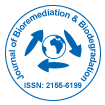当社グループは 3,000 以上の世界的なカンファレンスシリーズ 米国、ヨーロッパ、世界中で毎年イベントが開催されます。 1,000 のより科学的な学会からの支援を受けたアジア および 700 以上の オープン アクセスを発行ジャーナルには 50,000 人以上の著名人が掲載されており、科学者が編集委員として名高い
。オープンアクセスジャーナルはより多くの読者と引用を獲得
700 ジャーナル と 15,000,000 人の読者 各ジャーナルは 25,000 人以上の読者を獲得
インデックス付き
- CAS ソース インデックス (CASSI)
- 索引コペルニクス
- Google スカラー
- シェルパ・ロミオ
- Jゲートを開く
- Genamics JournalSeek
- アカデミックキー
- ジャーナル目次
- 研究聖書
- 中国国家知識基盤 (CNKI)
- ウルリッヒの定期刊行物ディレクトリ
- Global Online Research in Agriculture (AGORA) へのアクセス
- レフシーク
- ハムダード大学
- エブスコ アリゾナ州
- OCLC-WorldCat
- SWBオンラインカタログ
- パブロン
- ジュネーブ医学教育研究財団
- ミアル
- ICMJE
役立つリンク
オープンアクセスジャーナル
このページをシェアする
抽象的な
Ex-Situ Bioremediation of Polycyclic Aromatic Hydrocarbons in Sewage Sludge Ex-Situ Bioremediation of Polycyclic Aromatic Hydrocarbons in Sewage Sludge
Luecy FFera
Polycyclic aromatic hydrocarbons (PAHs) are hazardous organic pollutants commonly found in sewage sludge, posing risks to the environment and human health. Ex-situ bioremediation techniques provide a promising solution for the removal and degradation of PAHs in sewage sludge. This abstract presents a summary of the methods and challenges associated with ex-situ bioremediation of PAHs in sewage sludge.
Various ex-situ bioremediation techniques, including composting, landfarming, bioreactors, and phytoremediation, have been employed to treat PAH-contaminated sewage sludge. Composting utilizes microorganisms to degrade PAHs during the natural decomposition of organic matter, while landfarming relies on indigenous microorganisms in soil to facilitate PAH degradation. Bioreactors offer controlled environments for the biodegradation of PAHs, with different types suitable for aerobic, anaerobic, or hybrid processes. Phytoremediation involves the use of plants to uptake and break down PAHs in sewage sludge. However, several challenges must be addressed for effective exsitu bioremediation. The complexity of PAH mixtures, variations in sludge characteristics, and inhibitory substances can impact degradation rates. Optimization of environmental factors, microbial consortia selection, and the use of genetically engineered microorganisms hold promise for improving PAH removal efficiency. Integration of different bioremediation techniques and monitoring the fate and transport of PAHs post-treatment are crucial for long-term effectiveness and risk mitigation.

 English
English  Spanish
Spanish  Chinese
Chinese  Russian
Russian  German
German  French
French  Portuguese
Portuguese  Hindi
Hindi